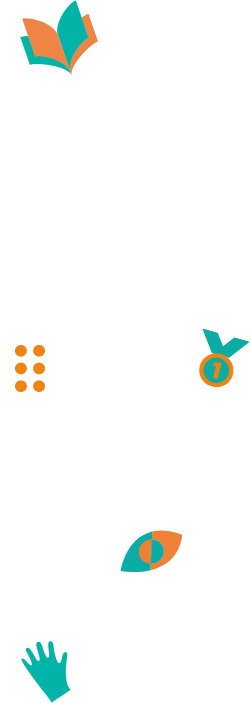In 2024, the Typhlo & Tactus international jury analyzed 69 designs from 17 participating countries for 2 days 1/2.
All the books
Page 2 / 15
Devine ? (Guess ?) - Martine Christoff - Belgium
Strong points:
- It’s an original subject.
- For the little ones it works.
- It’s similar to seven mice in the dark.
- The children focus on an object in a clear space.
- It starts from the back and it’s funny.
Proposition: Put Braille in the ? title guess.
Points to improve:
- The story doesn’t tell much.
- It would be better if the animal was whole.
- It’s treated in a rather simple way.
- The subjects are not the same throughout
the book for the same character. - Improve the text.
The jury’s opinion
Les chaussettes d'Oscar (Oscar's socks) - Anne Ferrier & Carmen Gayo Raton - Belgium
Strong points:
- The materials are very, very original.
- Beautiful contrasts and bright colors.
- The text is very interesting.
- The choice of materials is highly relevant.
- The quality of the materials creates
an emotional reading experience. - The design technique is very beautiful..
- The book is large but light.
The jury’s opinion
Pinpin joue à cache-cache (Bunny plays hide-and-seek) - Monique Sommer & Marcelle Peters - Belgium
Strong points:
- The subject is interesting and original, it names emotions, COVID.
- The animals are grateful and very interactive.
- The images can make sound depending on the gesture.
- The subject of disgust is very relevant.
- A book to help children concentrate.
- Allows for in-depth discussion of emotion.
- Beautiful, tactile definition of emotions.
Points to improve:
- No games in the book
- Not a book in the shape of books
- The box gives an instinctive reading,
this confuses the overall picture. - This can be tiring for children.
- There is a lack of autonomy in relation
to the format of the book.
The jury’s opinion
Qui est Lili ? (Who is Lili ?) - Michèle Mestrez - Belgium
Strong points:
- The material is well chosen.
- It’s a good story. The idea is interesting.
- The handling is appropriate
for producing sounds.
Points to improve:
- This book is heavy, very dangerous.
This makes it difficult to read. - It is complicated to open with separate boards.
- Little understanding of the character Lily.
- Difficult to handle.
- The ladder is not in the right place,
the repairs are not at the same level.
The jury’s opinion
Jeux de trames (Frame sets) - Catherine Brison - Belgium
Strong points:
- It’s a beautiful design.
- The discovery of interesting
sounds is fun and surprising. - It’s hard-wearing.
- It requires several modes of touch
for tactile exploration. - It’s ambitious, excellent
and exploration is infinite. - Despite the highly visual plot, you
can explore by touch and by feel.
Points à améliorer:
- Complicated to discover the different boards.
- Difficult to understand.
- A little fragile.
- For some this is not a children’s book but
an artist’s book.
The jury’s opinion
























































